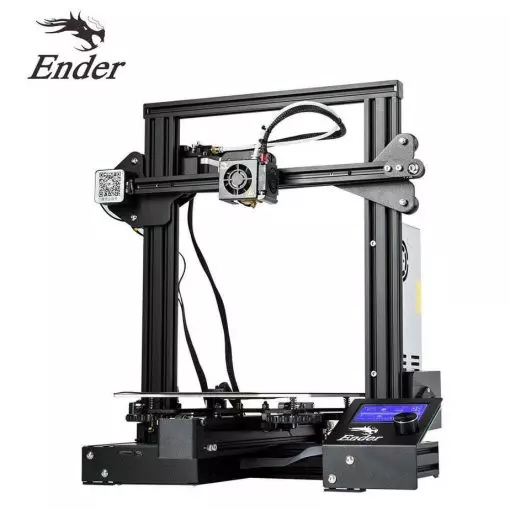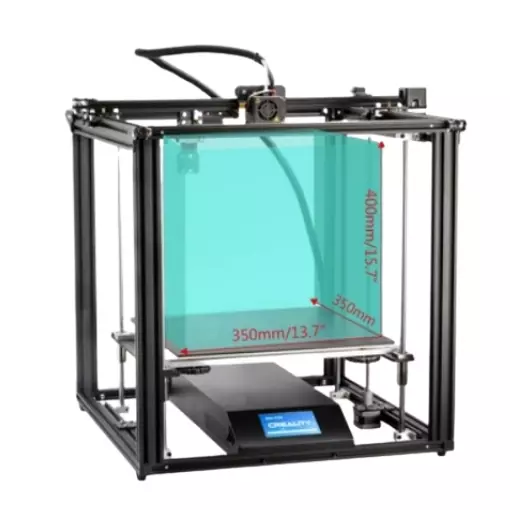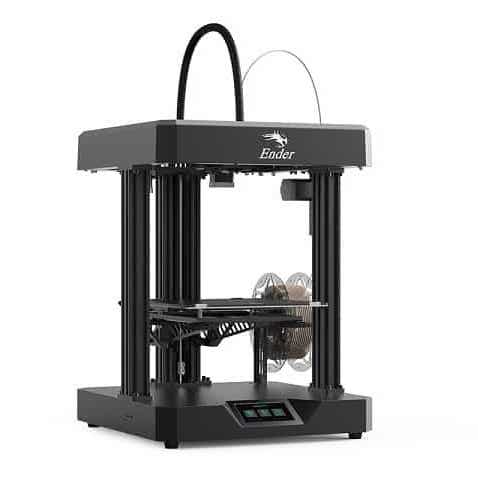Compare Ender 3 vs Ender 5 Plus vs Ender 7
Comparison between the best 3D printers
Choose the best 3D printer at the best price. The cheapest 3D printers are here.
Buy a 3D printer here with 3D Fila.
 |
 |
 |
|
| Model | Ender 3[BUY Ender 3] |
Ender 5 Plus[BUY Ender 5 Plus] |
Ender 7[BUY Ender 7] |
| Printing Material | Filament | Filament | Filament |
| Estimated price | $210,00 | $599,00 | $429,00 |
| Fabricante | Creality 3D | Creality 3D | Creality 3D |
| Release Year | 2018 | 2019 | 2021 |
| Print Volume [mm] | 220x220x250 | 350x350x400 | 250x250x300 |
| Printer Size [mm] | 440x440x465 | 632x619x666 | 430x460x570 |
| Weight [kg] | 6,62 | 18,2 | 17,2 |
| Power Loss Recovery | NO | YES | YES |
| Enclosed printer | NO | NO | NO |
| Bed Leveling | Manual | Automatic | Manual |
| Filament End Sensor | NO | YES | YES |
| Bed type | Heated | Heated | Heated |
| Power supply system | Bowden | Bowden | Bowden |
| Standard nozzle | 0,4 | 0,4 | 0,4 |
| Maximum Nozzle Temperature [°C] | 255 | 260 | 260 |
| Maximum Bed Temperature [°C] | 110 | 100 | 100 |
| Maximum printing speed [mm/s] | 180 | 180 | 250 |
| Filament holder | YES | YES | YES |
| Camera for supervision | NO | NO | NO |
| Recommended filaments | PLA, TPU, ABS, PETG | PLA, TPU, ABS, PETG | PLA, PETG, Tritan, Flex, ABS |
| Recommended slicers | Cura, Simplify, Slic3r | Cura, Simplify, Slic3r | Cura, Simplify, Slic3r, IdeaMaker |
| Maximum Resolution [mm] | 0,1 | 0,1 | 0,1 |
| Processor | 8 bits | 32 bits | Creality CR-FDM V.2.4.S1_V101 32bits |
| Display | Mono | Touchscreen TFT 4,3'' | Display touchscreen 4,3'' |
| Power Supply | 24V / 270W | 24V / 504W | 110/220V / 350W |
| Connectivity | SD / USB | SD / USB | SD / USB |
| Operating systems | Windows, Mac, Linux | Windows, Mac, Linux | Windows, Mac, Linux |
| Date of registration in the system | 2021-04-13 | 2021-04-14 | 2022-11-04 |
| Release date | 2018 | 2019 | 2021 |
| Extra features | The Ender 3 V1 is a DIY assembly 3D printer, a sales leader since 2017, standing out for its cost-benefit. With a wide printing capacity, it has a CNC machined structure for precision and stability. It offers high-precision prints with low noise, thanks to its innovative V-profile and pulleys. It has a self-adhesive magnetic platform for easy removal of models and excellent adhesion. The Ender 3 heats up quickly, reaching 100°C in 5 minutes, ideal for agile prints. It includes protection against power failures, allowing you to resume printing after interruptions, saving time and material. | The Ender 5 Plus offers a large print volume (350x350x400 mm) and fast assembly. It includes a BLTouch sensor, but with range limitations. It stands out for its dimensional accuracy, although it requires adjustments to the slicer settings. Despite the noise, its integrated design saves space, and includes features such as a filament sensor and power resumption. Ideal for large projects, it requires refinement in the settings for high-quality prints. | Crealitys Ender 7 printer offers remarkable print speeds, utilizing CoreXY kinematics for precise and fast movement. With a 250x250x300mm build area, dual direct extruder, and custom hotend, the Ender 7 is capable of printing at high speeds, although quality may suffer on smaller prints. Assembly is relatively straightforward, but the machine is noisy and can get hot. Its true speed potential is most noticeable on larger prints, where it outperforms its competitors. |
| Support for multiple colors and materials (AMS and CFS) | NO | NO | NO |
Notes * |
|||
| Cost-benefit | 6 / 10 | 6 / 10 | 7 / 10 |
| Hardware | 0.5 / 10 | 2 / 10 | 2.4 / 10 |
| Screen | . | . | . |
| Print volume | 3 / 10 | 4 / 10 | 4 / 10 |
| Performance | 1 / 10 | 1 / 10 | 2 / 10 |
| [BUY Ender 3] | [BUY Ender 5 Plus] | [BUY Ender 7] |
Conclusion |
| In comparing the three Creality 3D printers—the Ender 3, Ender 5 Plus, and Ender 7—several key factors emerge, particularly when considering their prices, features, and overall performance. The **Ender 3** stands out as the most budget-friendly option, offering excellent cost-effectiveness for users who are newcomers to 3D printing or those who prioritize basic functionality over advanced features. Despite its lower price point, it maintains a satisfactory print quality and a reasonable build volume. However, its manual bed leveling and lack of recovery features may be seen as limitations for more demanding users. On the other hand, the **Ender 5 Plus**, priced higher, introduces several enhancements aimed at providing an improved user experience. Its larger print volume is significant for larger projects, and the automatic bed leveling coupled with a filament sensor marks a step up in convenience and reliability. However, it still requires a bit of tuning and may not completely eliminate noise issues. Its price might be justified for serious hobbyists who need larger prints with decent accuracy. The **Ender 7** represents a more advanced choice in this lineup, emphasizing speed with its CoreXY kinematics, which allows for higher maximum print speeds. While it offers comparable print volume to the Ender 5 Plus, its dual direct extruder can enhance flexibility in filament use, catering to those looking to experiment with different materials. However, it struggles with maintaining quality on smaller prints and can be quite noisy, compromises that prospective buyers should consider given its higher price relative to the Ender 5 Plus. In conclusion, the choice among these printers ultimately depends on the user's specific needs and budget. The Ender 3 is ideal for beginners seeking an economical entry point, while the Ender 5 Plus offers a mix of usability and larger volume for those willing to invest more. The Ender 7 is suited for experienced users who prioritize printing speed and material versatility but are prepared to accept its drawbacks. Each model reflects a balance of price, functionality, and features that cater to different segments of the 3D printing market. |

